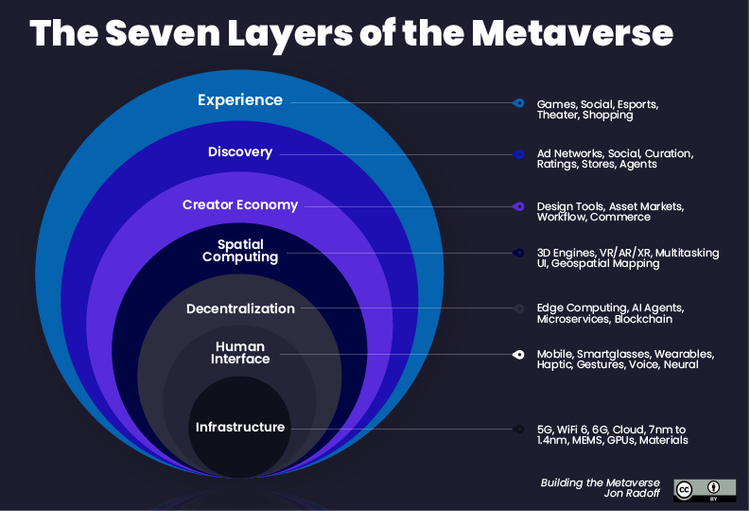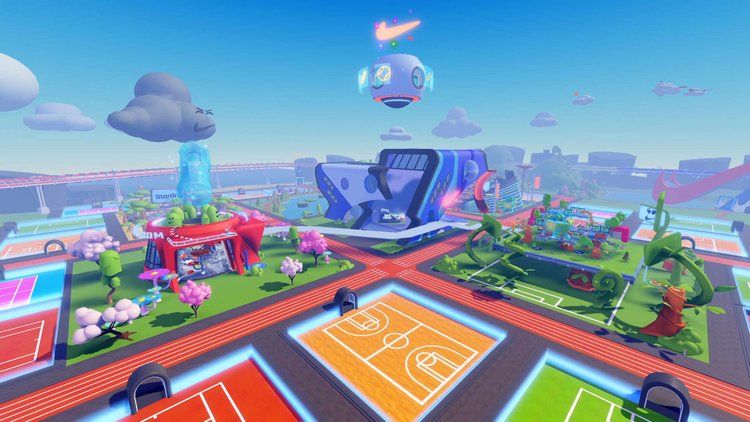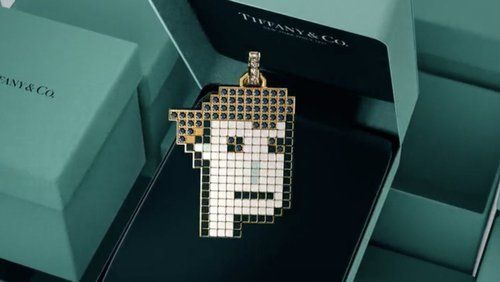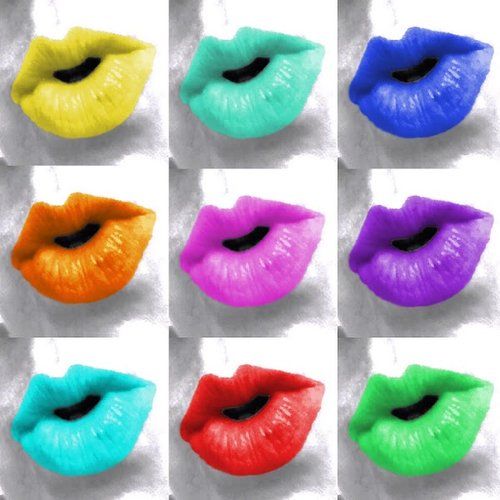What is the Metaverse?
Simply put, it's the future of the internet: A massively scaled persistent, interactive, and interoperable real-time platform comprised of interconnected virtual worlds and reality, where people can socialise, work, transact, play, and create.
Does the Metaverse exist yet? Not quite. For now, the fully immersive and interoperable version is a vision. However, the seeds are sown and it's just a matter of time.
There are however already different types of Metaverse use cases - so-called the "Multiverse", to explore, and although they are similar in offering, they all slightly differ (think of it like the fizzy drinks category: Coca Cola and Pepsi offer similar drinks, but you can still taste the difference).

The framework of the Metaverse that best describes the value-chain is based on on Jon Radoff's seven tiers model (see the illustration above). This includes opportunities, technological innovations and solutions to our current problems.
Infrastructure is the base layer, meaning that without adequate framework none of the other developments are possible. On top are the experiences. As Steve Jobs said: "You've got to start with the customer experience and work backwards to the technology - not the other way around". Currently games are the most advanced in the metaversal experiences.
Games: The gateway to the Metaverse
Already, nearly a hundred million people a day log onto Roblox, Minecraft, and Fortnite - platforms that operate tens of millions of interconnected worlds, which support a consistent virtual identity, virtual goods, communications suites, and can be accessed from most devices.
Nike: Magic is in the air

Originally, these games were pure games. In the last years, they have extended to social platforms, where people can connect: socialise, work and play. Concerts with Adriane Grande have attracted 12.5 millions of visitors, Nike has build a NIKELAND in the game, interacting with its store experience attracted 7 million users in a few months. Even primary and secondary education (also known as K-12 education) has been built in Roblox during the pandemic.
Nike advanced further in engaging their audience with the famous basketball player LeBron James to coach and socialise with the users of the game. A big part of their activities is related to building a community.
Another milestone for Nike. Last year, Nike officially acquired RTFKT Studios, a Web3 fashion house specialising in digital apparel. Shortly thereafter the company released RTFKT x Nike Dunks Genesis CryptoKicks, a pair of physical sneakers with their own NFT counterparts.
Two weeks ago expanded its lineup of NFT clothing with the RTFKT x Nike AR Genesis Hoodie, an exclusive digital hoodie for RTFKT's Clone X NFT avatars. In addition to the virtual item, each owner will also receive a physical hoodie equipped with a near-field communication chip (NFC) that allows for wireless communication between the clothing and its respective NFT.
Using a combination of trackers and QR codes, owners can bring their physical hoodies to life in AR with effects such as virtual wings. Moving forward, the company will introduce additional utilities to its catalog of digital clothing, such as tokens to access exclusive in-person events. Red Bull could give you wings in your imagination - now Nike can give you wings in reality.
The physical-digital transition goes even further. The Nike sneakers arrive a few weeks later and contain an embedded NFC chip the buyer can scan with their phone. It gives them another NFT that proves the authenticity of the shoes but could also offer other benefits, like exclusive admission to in-person events. The next time that brand releases a limited-edition physical item, it whitelists holders of that NFT, and the cycle continues.
A brand only needs to produce as many items as there are purchased NFTs

Other brands like Tiffany & Co. or Prada are among those using digital tokens to offer exclusive access to tangible goods and to create a community. Fashion brands have hit on use for NFTs that go beyond quirky experiments or digital art. They're using them as a gateway to old-fashioned physical products.
Because NFTs offer an easy way to offer holders exclusive benefits, it's not hard to imagine how brands could use the capability for capsule collections, early access to new releases, or custom styles. The scheme has a few advantages, such as building loyalty among a group of engaged fans, and because the brand only needs to produce as many items as there are purchased NFTs, there's less inventory risk involved and it's more sustainable.
Last week, Tiffany & Co. announced the launch of a custom jewelry program exclusively for owners of CryptoPunk NFTs that centers on what the company is calling NFTiffs.
To get a pendant, CryptoPunk holders first need to buy an NFTiff, which will cost them 30 ETH, or about 50,000 dollars at current conversion rates. It can then be redeemed during a set window for a pendant custom-designed by Tiffany, as well as an NFT resembling the physical item. Only for 250 people. Sold out.
The physical-digital transition goes even further
Because NFTs offer an easy way to offer holders exclusive benefits, it's not hard to imagine how brands could use the capability for capsule collections, early access to new releases, or custom styles. The scheme has a few advantages, such as building loyalty among a group of dedicated fans, and because the brand only needs to produce as many items as there are purchased NFTs, there's less inventory risk involved, being more sustainable.
The physical-digital transition goes even further. The Nike sneakers arrive a few weeks later and contain an embedded NFC chip the buyer can scan with their phone. It gives them another NFT that proves the authenticity of the shoes but could also offer other benefits, like exclusive admission to in-person events. The next time that brand releases a limited-edition physical item, it whitelists holders of that NFT, and the cycle continues.
Picture with kisses: this is how NFTs and a community can do good!


